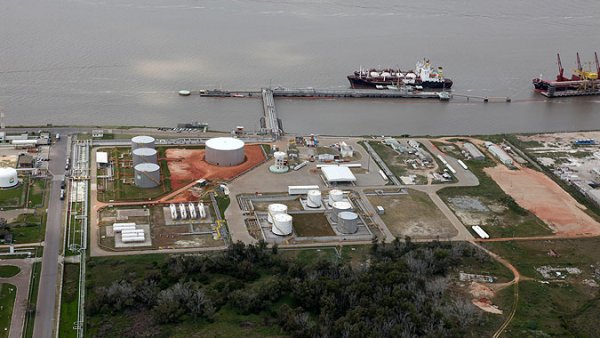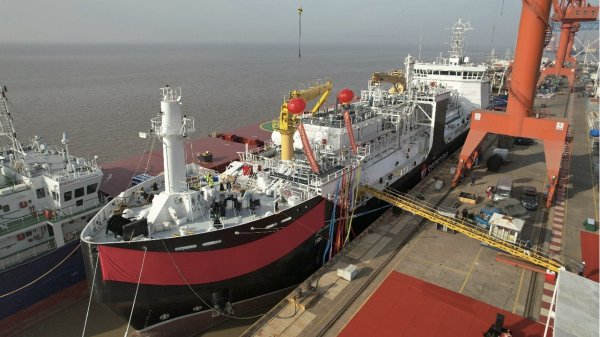Ships fitted with scrubbers in Great Lakes
Installation of exhaust gas cleaning technology for second vessel is due be completed on June 20th.
Interlake Steamship Company has had its 100-foot vessel, the M/V James R. Barker, outfitted with new exhaust gas cleaning technology - also known as scrubbers - as part of its ongoing effort to cut down on emissions.
The M/V James R. Barker set sail on Sunday with the new scrubbers. The company's 826-foot ship, M/V Lee A. Tregurtha, is to have the same upgrades completed on June 20th.
The exhaust gas cleaning technology, made by DuPont, was installed on Interlake's M/V Hon. James L. Oberstar in April of 2015 by Fincantieri Bay Shipbuilding, who also handled the second phase of installation on Barker and Tregurtha.
The new scrubbers are shorter and lighter than previous iterations, while retaining all of the same emissions-reducing benefits, according to DuPont's explanation of their product.
The exhaust moves from the ship's two engines to the scrubbers which strip impurities using sprays, eliminating any contained sulphur. The particulates that remain are then removed by a droplet separator. What's left is a cloud of clean white steam. It works "like a shower", Interlake Steamship Co. fleet engineer Drew Leonardi said, who estimated the cost of the scrubber installation to be around $4 million.
Another of Interlake's ships, the M/V Masabi Miner, is planned to be updated with the same scrubbers by 2017, for a total of five. These scrubbers are part of Interlake's plan to modernize their equipment. A re-power of their ship, the S.S. Herbert C. Jackson, will be the final step of Interlake's 10-year, $100-million-dollar modernization plan.
Legislation
Effective 1 January 2015, all ships that operate in the North American and European Emission Control Areas (ECAs) have been required to switch to fuel with a sulphur content not exceeding 0.1 percent or install scrubbers that meet the equivalency standard for suphur dioxide (SO2).
As an alternative, the International Maritime Organization (IMO) has allowed shipowners to install scrubbing systems as an equivalent to fuel switching. The systems are designed to reduce the SO2 content in the engine flue gas to below that found in a 0.1 percent sulphur fuel and therefore comply with existing ECA regulations.
Image: M/V James R. Barker
The M/V James R. Barker set sail on Sunday with the new scrubbers. The company's 826-foot ship, M/V Lee A. Tregurtha, is to have the same upgrades completed on June 20th.
The exhaust gas cleaning technology, made by DuPont, was installed on Interlake's M/V Hon. James L. Oberstar in April of 2015 by Fincantieri Bay Shipbuilding, who also handled the second phase of installation on Barker and Tregurtha.
The new scrubbers are shorter and lighter than previous iterations, while retaining all of the same emissions-reducing benefits, according to DuPont's explanation of their product.
The exhaust moves from the ship's two engines to the scrubbers which strip impurities using sprays, eliminating any contained sulphur. The particulates that remain are then removed by a droplet separator. What's left is a cloud of clean white steam. It works "like a shower", Interlake Steamship Co. fleet engineer Drew Leonardi said, who estimated the cost of the scrubber installation to be around $4 million.
Another of Interlake's ships, the M/V Masabi Miner, is planned to be updated with the same scrubbers by 2017, for a total of five. These scrubbers are part of Interlake's plan to modernize their equipment. A re-power of their ship, the S.S. Herbert C. Jackson, will be the final step of Interlake's 10-year, $100-million-dollar modernization plan.
Legislation
Effective 1 January 2015, all ships that operate in the North American and European Emission Control Areas (ECAs) have been required to switch to fuel with a sulphur content not exceeding 0.1 percent or install scrubbers that meet the equivalency standard for suphur dioxide (SO2).
As an alternative, the International Maritime Organization (IMO) has allowed shipowners to install scrubbing systems as an equivalent to fuel switching. The systems are designed to reduce the SO2 content in the engine flue gas to below that found in a 0.1 percent sulphur fuel and therefore comply with existing ECA regulations.
Image: M/V James R. Barker

|
IMO approves pricing mechanism based on GHG intensity thresholds
Charges to be levied on ships that do not meet yearly GHG fuel intensity reduction targets. |
|
|
|
||

|
VARO Energy expands renewable portfolio with Preem acquisition
All-cash transaction expected to complete in the latter half of 2025. |
|
|
|
||

|
NYK trials biofuel in milestone coal carrier test
Vessel is used to test biofuel for domestic utility company. |
|
|
|
||

|
H-Line Shipping orders LNG bunkering vessel
Vessel with 18,000-cbm capacity to run on both LNG and MDO. |
|
|
|
||

|
How to engineer and manage green shipping fuels | Stanley George, VPS
Effective management strategies and insights for evolving fuel use. |
|
|
|
||

|
Swedish government bans scrubber wastewater discharges
Discharges from open-loop scrubbers to be prohibited in Swedish waters from July 2025. |
|
|
|
||

|
MAN Energy Solutions achieves 100% load milestone for ammonia engine
Latest tests validate fuel injection system throughout the entire load curve. |
|
|
|
||

|
Petrobras secures ISCC EU RED certification for B24 biofuel blend at Rio Grande
Blend consisting of 24% FAME is said to have been rigorously tested to meet international standards. |
|
|
|
||

|
Stolt-Nielsen to fully control Avenir LNG with acquisition
Share purchase agreement to buy all shares from Golar LNG and Aequitas. |
|
|
|
||

|
Bureau Veritas supports launch of CIMC SOE's LNG bunkering vessel
Handover of Seaspan Energy's cutting-edge 7,600-cbm vessel completed. |
|
|
|
||
Related Links
- · Steam-powered vessel arrives at shipyard for repowering [Insights]
- · Interlake Steamship to install more scrubbers [Insights]
- · Bulk carrier installs SOx scrubber monitor [Insights]
- · New 'Scrubber Ready' class notation announced [Insights]
- · 'Valuable fuel ecomony' for boxships with scrubber retrofit [Insights]
- · United States [Directory]

